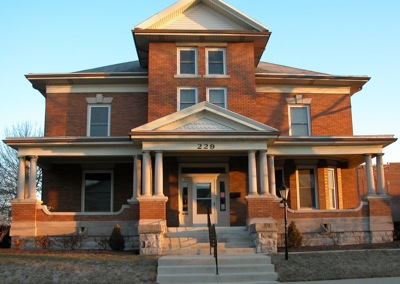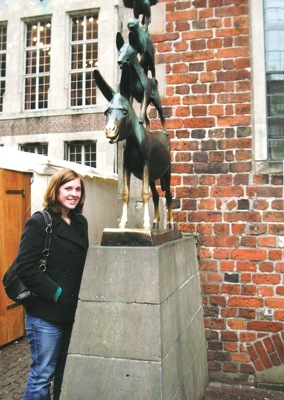Friday, February 13th, 2009
Old rectories get new jobs
By Shelley Grieshop

Photo by Shelley Grieshop/The Daily Standard
The rectory of Immaculate Conception Catholic Church in Celina, above, is still used as a dwelling for the parish priest as well as office space. However, due to the decrease in the number of priests, many parish rectories serve only as a place for religion classes and/or parish meeting sites.
Years ago, Catholic church rectories served as homes for priests, office space and a place where Sunday collections were counted.
Today, many local rectories - most built beside churches - are used mainly for religion classes and parish council meetings. The reason: less priests to fill them. Parishes are now clustered together with one or two priests serving more than three communities.
A prime example is the Fort Recovery cluster of Catholic churches, which currently owns rectories in all four of its parishes. The one in Sharpsburg houses the two priests that serve the cluster. The rectory at St. Peter is leased to an area family and another at Mary Help of Christians in Fort Recovery is used only as an office. The fourth on St. Joe Road is used for storage and as a dressing room for brides and bridesmaids prior to weddings.
"Currently, because the (St. Joe) rectory is in such bad condition and because it has become a money pit, since it still needs to be heated to some extent, the parish council is considering tearing it down," said the Rev. Thomas Dorn, pastor of the Fort Recovery cluster.
Many local rectories are roomy, two-story brick buildings that could accommodate a family of five.
As churches across the country tighten their belts to survive the economy, some have sold off rectories to increase cash flow. However, that doesn't appear to be the case locally. Area priests told The Daily Standard their parishioners don't mind paying upkeep on the buildings since most still serve the parishes in some manner.
"We don't plan to sell," said the Rev. Rich Nieberding, pastor of St. Augustine parish in Minster and St. Joseph parish in Egypt.
Nieberding said the rectory in Minster is used 24/7.
"I live there," he added with a chuckle.
The one in Egypt is no longer home to male clergy, and instead is used as a residence for two Precious Blood sisters, he explained.
The Rev. Rick Walling, pastor of the Coldwater cluster of parishes, lives in the Coldwater rectory. The former sister convent situated next door is now used as office space. The rectory at St. Anthony, "the big old house," as he calls it, continues to be used for religion classes and as a community center.
Several years ago the former rectory in Philothea was sold and moved from its foundation across the road to the east, where it now serves as a home for an area family. Church officials like the idea that its history lives on, Welling said.
Although the Archdiocese of Cincinnati holds the deeds to most, if not all local rectories, the buildings belong to each parish, according to archdiocese spokesman Dan Andriacco.
"It's really up to each parish to decide what to do with them," he said.
The same is true for former convents and schools that no longer are needed or are in poor condition, he added.
However, major transactions such as sales or destruction of buildings need approval by special committees of the archdiocese after local parish councils give their thumbs up, he added.
However, church officials who are contemplating selling their minimally-used rectories might think twice these days, Andriacco advised.
"Now might not be the time due to the economic situation," he said.




